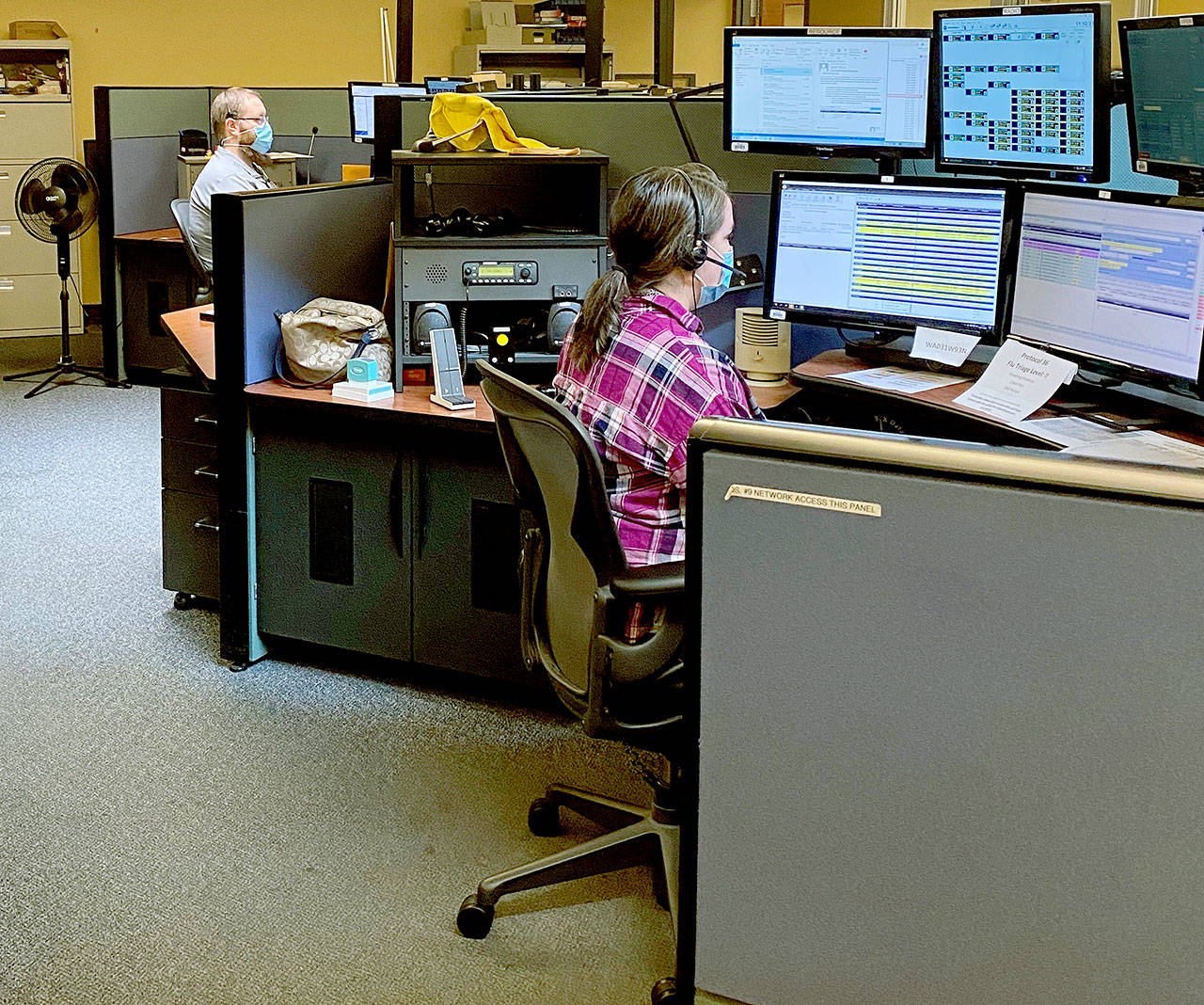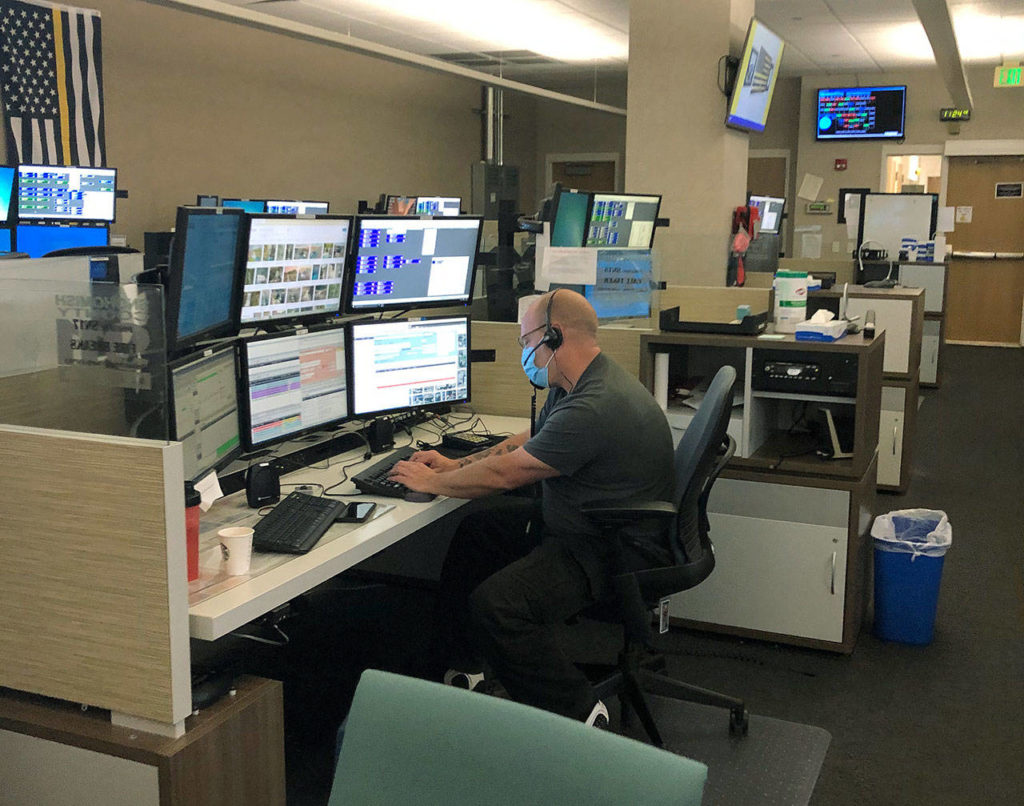EVERETT — It could have been a disaster for the Snohomish County 911 dispatch center in September.
After working 1½ shifts in a room with other radio dispatchers, in the glass-walled building that’s like a nerve center for all first-responders in Snohomish County, a dispatcher learned her COVID-19 test had come back positive.
“We had to scramble, and ended up testing about a third of our staff,” Snohomish County 911 director Kurt Mills said.
At a given time, up to 25 people are running the emergency lines in the county of 800,000 residents. Another 40 employees work in IT and support roles.
Staffers alerted dispatchers who were getting ready to come in for their shifts. The Everett Fire Department helped with rapid test kits for everyone who worked with the infected employee. Some were tested twice, to be sure. Results came back in 20 minutes. All were negative, and the employee has since recovered.
But it could’ve been far worse, if Snohomish County 911 hadn’t been preparing for this exact scenario since the pandemic began.
It could have been like Puerto Rico, where both of the island’s 911 centers shut down Wednesday due to workers testing positive for the viral disease.
Like most of us, Mills had never heard the term “social distancing” until February, when it became a buzzword we would be glad to leave behind in 2020.
“How are we going to socially distance our staff in a 911 center?” Mills wondered. “These $100,000 work stations are anchored to the floor, you can’t move them around even if you have the space.”
Most workplaces can press the pause button for a day, if needed. You can’t stop taking 911 calls, even for a moment.
And in a pandemic, if anything, the dispatch center becomes a resource that’s more essential than ever.
Fortunately, when the county’s two emergency call centers SNOCOM and SNOPAC merged in 2018, officials decided to keep both buildings open and outfitted for use, in case an unforeseen catastrophe struck the main campus along Everett Mall Way.
“We actually have drilled before, what would happen if we had to abandon our main center and pile into a van and sprint down to Mountlake Terrace, which is about 15 miles away,” Mills said.
It was not an instant, four-alarm fire kind of move, but since March, staff has been split roughly 50-50 at the two buildings. That allows dispatchers to sit with an open work station between them, creating physical distance — and limiting the number of people who are exposed, if and when a coworker tests positive.
In terms of the gear and technology, the backup site is always ready. But from a practical perspective? Well, for one thing, the microwave in the break room didn’t work, so they had to get a new one. They also had to move furniture around and convert meeting spaces into extra break rooms, creating distance so people could take off face coverings to eat lunch.
Meanwhile, no visitors are allowed, employees are provided with masks, and workers are screened with temperature checks at the door. One challenge of this virus is that people can feel symptom-free, but still be infected and spread it — eventually killing others, especially the elderly and those with lung problems.
Some 911 center employees have arrived at work not realizing they’re running a fever. They’ve been tested.
Some employees have called in saying they don’t feel well. They’ve been tested, too.
Anybody who can work from home is working from home, but that excludes dispatchers. Some IT and support staffers need to be onsite, too.
With the backup center in use, dispatchers needed a new backup for the backup — a so-called “tertiary center” set up in vacant office space near the north campus. It has been used on busy days like the Fourth of July, and also for training.
Pandemic-related costs amounted to about $185,000, in all, for Snohomish County 911, Mills said. About 80% of those expenses were covered by grants. The remainder came out of the agency’s budget.
The most significant purchases were software and hardware to install 911 phones at the third center.
Snohomish County dispatchers field calls from Edmonds to Stanwood to Darrington to Index.
Fire engines don’t appear by magic. It’s a dispatcher taking the 911 call and sending firefighters, police officers and other first-responders to the scene.
A dispatcher has to be calm but urgent, a reassuring voice in the face of constant multi-tasking, capable of dealing with life-or-death situations every day.
This was not just the summer of a pandemic. There was social unrest, wildfires and then all the usual stresses of the job.
“It’s kind of the trifecta of things,” Mills said. “Our dispatchers are professionals. They’re empathetic. They deal with the best and the worst of society every day, the bad things that happen in our community. And they work through it like a champ. But we’re people, we feel the pain as well, the struggles, and I couldn’t be more proud of how we’ve worked through this together and maintained that lifeline for the community.”
The local 911 center had played a behind-the-scenes support role in response to the first known novel coronavirus case in the United States.
In January, a Snohomish County man, 35, arrived at an urgent care clinic after four days with a bad cough. He had an ever-so-slightly high temperature of 99 degrees, but tested negative for the flu, rhinovirus and four common strains of coronavirus. He’d just returned from a trip to Wuhan, China.
Shortly thereafter, he became the first person on U.S. soil to test positive for 2019-nCoV — better known as COVID-19. Dispatchers helped to coordinate the response that brought him to Providence Regional Medical Center Everett. The man recovered, but the virus was here. It was a wake-up call that made the 911 center begin planning for what was to come, much earlier than many other places.
Within about a day of the positive test, Snohomish County dispatchers became perhaps the first in the nation to begin using a triage tool in their Medical Priority Dispatch System. It’s known as Protocol 36, and in spite of what it sounds like, no, it’s not an evil secret plan out of a James Bond movie.
Modeled after lessons learned from SARS, H1N1 and other outbreaks, Protocol 36 helps paramedics to screen who needs a high-priority response, and who can wait. For example, in the beginning, if someone called saying they had flu-like symptoms, the protocol advised dispatchers to ask about recent travel to China. Later, when it was clear the outbreak spread well beyond Wuhan, questions become more about identifying symptoms. As a pandemic becomes more serious in a region, it becomes more critical to be as smart as possible in deploying resources — when ambulances and hospital beds near capacity.
Data collected by the Annals of Emergency Dispatch & Response suggested Protocol 36 made emergency medical responses far more efficient and more in line with what each call needed.
As the pandemic hit its first spike in spring, several odd trends and data blips emerged. For example, around when people started to see $600 checks from the federal government to make up for lost wages, reports of fraud skyrocketed in Snohomish County, because identity thieves were gaming the system.
There were 2,502 fraud reports in May 2020, compared to 449 in the same month last year.
Many of those calls went to a non-emergency line, but the same dispatch employees answer the phones.
Also, compared to the previous May:
The number of car crashes went from 146 to 65, with fewer people on the road.
Carbon monoxide alarms more than doubled.
Suicide reports decreased by 41%.
There was also a roughly 50% bump in the number of people reporting symptoms potentially related to COVID-19, especially around March.
At the dispatch centers, no other workers have tested for COVID-19 since September. As winter nears and a third wave of the virus roars its way across the country, Mills would prefer to keep it that way.
Caleb Hutton: 425-339-3454; chutton@heraldnet.com. Twitter: @snocaleb.
Talk to us
> Give us your news tips.
> Send us a letter to the editor.
> More Herald contact information.


























